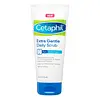What's inside
What's inside
 Key Ingredients
Key Ingredients

 Benefits
Benefits

 Concerns
Concerns

 Ingredients Side-by-side
Ingredients Side-by-side

Water
Skin ConditioningCocamidopropyl Betaine
CleansingDisodium Cocoamphodiacetate
CleansingCoco-Glucoside
CleansingSodium Cocoamphoacetate
CleansingGlycerin
HumectantPanthenol
Skin ConditioningTocopheryl Acetate
AntioxidantBambusa Arundinacea Stem Extract
Skin ConditioningSodium Hydroxide
BufferingSodium Benzoate
MaskingSodium Citrate
BufferingXanthan Gum
EmulsifyingHeliotropine
MaskingPhenoxyethanol
PreservativePolyquaternium-10
Acrylates/C10-30 Alkyl Acrylate Crosspolymer
Emulsion StabilisingCitric Acid
BufferingParfum
MaskingWater, Cocamidopropyl Betaine, Disodium Cocoamphodiacetate, Coco-Glucoside, Sodium Cocoamphoacetate, Glycerin, Panthenol, Tocopheryl Acetate, Bambusa Arundinacea Stem Extract, Sodium Hydroxide, Sodium Benzoate, Sodium Citrate, Xanthan Gum, Heliotropine, Phenoxyethanol, Polyquaternium-10, Acrylates/C10-30 Alkyl Acrylate Crosspolymer, Citric Acid, Parfum
Water
Skin ConditioningPumice
AbrasiveCaprylic/Capric Triglyceride
MaskingIsopropyl Palmitate
EmollientStearyl Alcohol
EmollientBehenyl Alcohol
EmollientCetyl Alcohol
EmollientSodium Cocoamphoacetate
CleansingLauryl Glucoside
CleansingSodium Cocoyl Glutamate
CleansingSodium Lauryl Glucose Carboxylate
CleansingGlycerin
HumectantPolyquaternium-7
Steareth-2
EmulsifyingSteareth-21
CleansingCarbomer
Emulsion StabilisingSea Salt
AbrasiveButyrospermum Parkii Butter
Skin ConditioningVaccinium Myrtillus Fruit Extract
Skin ConditioningSaccharum Officinarum Extract
MoisturisingAcer Saccharum Extract
Skin ConditioningCitrus Aurantium Dulcis Fruit Extract
MaskingCitrus Limon Fruit Extract
MaskingCocos Nucifera Fruit Extract
EmollientCocos Nucifera Oil
MaskingRicinodendron Rautenenii Seed Oil
Skin ConditioningRosa Moschata Seed Oil
EmollientParfum
MaskingPhenoxyethanol
PreservativeDehydroacetic Acid
PreservativeBenzyl Alcohol
PerfumingCI 15985
Cosmetic ColorantCI 14700
Cosmetic ColorantCI 16035
Cosmetic ColorantWater, Pumice, Caprylic/Capric Triglyceride, Isopropyl Palmitate, Stearyl Alcohol, Behenyl Alcohol, Cetyl Alcohol, Sodium Cocoamphoacetate, Lauryl Glucoside, Sodium Cocoyl Glutamate, Sodium Lauryl Glucose Carboxylate, Glycerin, Polyquaternium-7, Steareth-2, Steareth-21, Carbomer, Sea Salt, Butyrospermum Parkii Butter, Vaccinium Myrtillus Fruit Extract, Saccharum Officinarum Extract, Acer Saccharum Extract, Citrus Aurantium Dulcis Fruit Extract, Citrus Limon Fruit Extract, Cocos Nucifera Fruit Extract, Cocos Nucifera Oil, Ricinodendron Rautenenii Seed Oil, Rosa Moschata Seed Oil, Parfum, Phenoxyethanol, Dehydroacetic Acid, Benzyl Alcohol, CI 15985, CI 14700, CI 16035
 Reviews
Reviews

Ingredients Explained
These ingredients are found in both products.
Ingredients higher up in an ingredient list are typically present in a larger amount.
Glycerin is already naturally found in your skin. It helps moisturize and protect your skin.
A study from 2016 found glycerin to be more effective as a humectant than AHAs and hyaluronic acid.
As a humectant, it helps the skin stay hydrated by pulling moisture to your skin. The low molecular weight of glycerin allows it to pull moisture into the deeper layers of your skin.
Hydrated skin improves your skin barrier; Your skin barrier helps protect against irritants and bacteria.
Glycerin has also been found to have antimicrobial and antiviral properties. Due to these properties, glycerin is often used in wound and burn treatments.
In cosmetics, glycerin is usually derived from plants such as soybean or palm. However, it can also be sourced from animals, such as tallow or animal fat.
This ingredient is organic, colorless, odorless, and non-toxic.
Glycerin is the name for this ingredient in American English. British English uses Glycerol/Glycerine.
Learn more about GlycerinParfum is a catch-all term for an ingredient or more that is used to give a scent to products.
Also called "fragrance", this ingredient can be a blend of hundreds of chemicals or plant oils. This means every product with "fragrance" or "parfum" in the ingredients list is a different mixture.
For instance, Habanolide is a proprietary trade name for a specific aroma chemical. When used as a fragrance ingredient in cosmetics, most aroma chemicals fall under the broad labeling category of “FRAGRANCE” or “PARFUM” according to EU and US regulations.
The term 'parfum' or 'fragrance' is not regulated in many countries. In many cases, it is up to the brand to define this term.
For instance, many brands choose to label themselves as "fragrance-free" because they are not using synthetic fragrances. However, their products may still contain ingredients such as essential oils that are considered a fragrance by INCI standards.
One example is Calendula flower extract. Calendula is an essential oil that still imparts a scent or 'fragrance'.
Depending on the blend, the ingredients in the mixture can cause allergies and sensitivities on the skin. Some ingredients that are known EU allergens include linalool and citronellol.
Parfum can also be used to mask or cover an unpleasant scent.
The bottom line is: not all fragrances/parfum/ingredients are created equally. If you are worried about fragrances, we recommend taking a closer look at an ingredient. And of course, we always recommend speaking with a professional.
Learn more about ParfumPhenoxyethanol is a preservative that has germicide, antimicrobial, and aromatic properties. Studies show that phenoxyethanol can prevent microbial growth. By itself, it has a scent that is similar to that of a rose.
It's often used in formulations along with Caprylyl Glycol to preserve the shelf life of products.
We don't have a description for Sodium Cocoamphoacetate yet.
Water. It's the most common cosmetic ingredient of all. You'll usually see it at the top of ingredient lists, meaning that it makes up the largest part of the product.
So why is it so popular? Water most often acts as a solvent - this means that it helps dissolve other ingredients into the formulation.
You'll also recognize water as that liquid we all need to stay alive. If you see this, drink a glass of water. Stay hydrated!
Learn more about Water